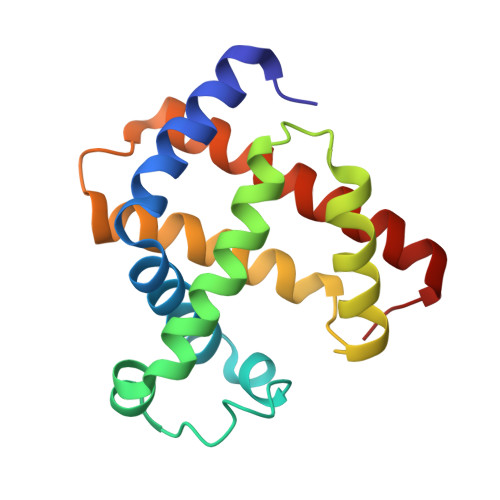Crystal Structures and Coordination Behavior of Aqua- and Cyano-Co(III) Tetradehydrocorrins in the Heme Pocket of Myoglobin
Morita, Y., Oohora, K., Mizohata, E., Sawada, A., Kamachi, T., Yoshizawa, K., Inoue, T., Hayashi, T.(2016) Inorg Chem 55: 1287-1295
- PubMed: 26760442
- DOI: https://doi.org/10.1021/acs.inorgchem.5b02598
- Primary Citation of Related Structures:
5AZQ, 5AZR - PubMed Abstract:
Myoglobins reconstituted with aqua- and cyano-Co(III) tetradehydrocorrins, rMb(Co(III)(OH2)(TDHC)) and rMb(Co(III)(CN)(TDHC)), respectively, were prepared and investigated as models of a cobalamin-dependent enzyme. The former protein was obtained by oxidation of rMb(Co(II)(TDHC)) with K3[Fe(CN)6]. The cyanide-coordinated Co(III) species in the latter protein was prepared by ligand exchange of rMb(Co(III)(OH2)(TDHC)) with exogenous cyanide upon addition of KCN. The X-ray crystallographic study reveals the hexacoordinated structures of rMb(Co(III)(OH)(TDHC)) and rMb(Co(III)(CN)(TDHC)) at 1.20 and 1.40 Å resolution, respectively. The (13)C NMR chemical shifts of the cyanide in rMb(Co(III)(CN)(TDHC)) were determined to be 108.6 and 110.6 ppm. IR measurements show that the cyanide of rMb(Co(III)(CN)(TDHC)) has a stretching frequency peak at 2151 cm(-1) which is higher than that of cyanocobalamin. The (13)C NMR and IR measurements indicate weaker coordination of the cyanide to Co(III)(TDHC) relative to cobalamin, a vitamin B12 derivative. Thus, the extent of π-back-donation from the cobalt ion to the cyanide ion is lower in rMb(Co(III)(CN)(TDHC)). Furthermore, the pK(1/2) values of rMb(Co(III)(OH2)(TDHC)) and rMb(Co(III)(CN)(TDHC)) were determined by a pH titration experiment to be 3.2 and 5.5, respectively, indicating that the cyanide ligation weakens the Co-N(His93) bond. Theoretical calculations also demonstrate that the axial ligand exchange from water to cyanide elongates the Co-N(axial) bond with a decrease in the bond dissociation energy. Taken together, the cyano-Co(III) tetradehydrocorrin in myoglobin is appropriate for investigation as a structural analogue of methylcobalamin, a key intermediate in methionine synthase reaction.
Organizational Affiliation:
Department of Applied Chemistry, Graduate School of Engineering, Osaka University , Suita 565-0871, Japan.


















